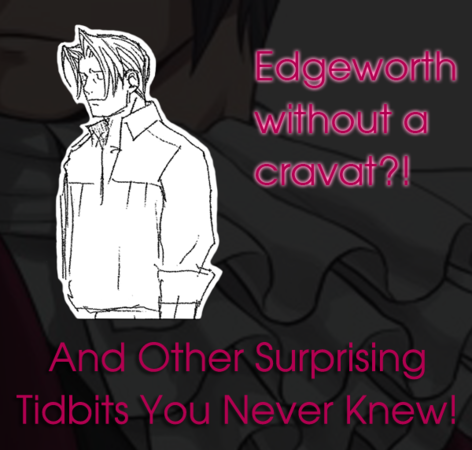
Ace Attorney Trilogy – Surprising Tidbits You Never Knew!
Oct 31, 2014 // Janet Hsu
It’s that time of the year again, and even Japan is starting to get in on the Halloween action (I’ve seen more Halloween decorations this year than in the 11 previous years combined! But medium-sized pumpkins suitable for carving still cost $50 or more… *sigh*). As I can’t personally hand out candy to all of you, I figured I’d hand out nuggets of info and trivia treats instead.

Edgeworth: How could you take a sketch of me looking tired after a hard day’s work and turn it into an innuendo-laden header like that!
Janet: *shrug* I figured that since there’s an abundance of sexy costumes for women in real life, it’s only fair that our fans that appreciate the male form get some eye-candy this Halloween, too.
Edgeworth: But why did it have to be me?!
Janet: …Are you really still that oblivious??? *sigh* Don’t worry, the rest of this entry is as wholesome as chocolate chip oatmeal cookies.
========================================
As with any project where a bunch of interesting people get together to make something, there is always at least one silly story worth sharing. From Mr. Iwamoto’s dev blog (click on “岩元コラム ”) for AA3, we have this little gem…
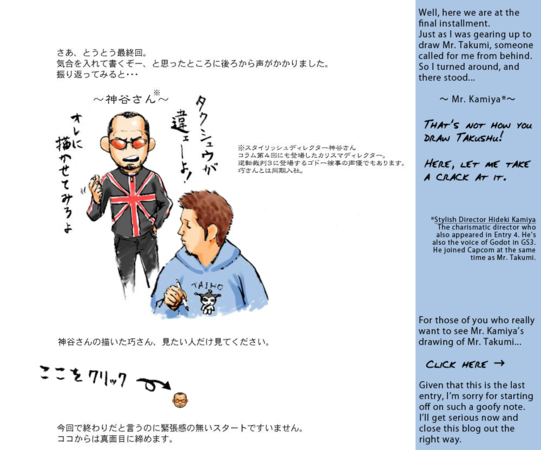
How did Mr. Kamiya’s drawing turn out? Well, in the spirit of fairness, only click on this little Mr. Kamiya head if you really want to see!

And on that note, here are some notes of interest about the Trilogy games! I’m only including things that I have rarely or never seen on the internet, so hopefully, these will be all new for even you super-fans. Be warned that there are some spoilers for the games, so proceed at your own risk!
Phoenix Wright: Ace Attorney
– The secret to Ace Attorney’s simple game design is that Mr. Takumi wanted to make games that were easy enough for even his non-gamer mother to pick up and play.
– When sitting down to write an Ace Attorney, Mr. Takumi has an internal ranking system of each episode’s importance that he follows. The most important episode is always episode 1, followed by episode 2, followed by the final episode of the game. While people may wonder why the first and second episodes are more important than the final episode, Mr. Takumi says that it’s because the role of the first episode is to make players like the game, followed by the second episode, which is to solidify their interest.
– The original Japanese version of AA1 only had four episodes. The fifth episode, “Rise from the Ashes”, was added 4 years later when the game was brought to the Nintendo DS. When creating episode 5, Mr. Takumi wanted to make sure it linked up story-wise with why Edgeworth disappeared in AA2, so he approached it from the angle of “what would be the most damaging to Edgeworth’s psyche?” Therefore, despite the seriousness of a topic like police corruption, he felt that corruption and betrayal from within the prosecutor’s office was the way to go.
– The class trial in episode 4 is based on something that happened to Mr. Takumi in real life when he was in 2 nd grade. Here’s what he had to say about it in his AA1 dev blog:
I was playing in my school’s courtyard when I found a small piggy bank out by the trash area. Inside was a single 5-yen coin. Thinking nothing of it, I put the coin in my pocket.
The next day, I was forced by a teacher I didn’t know to stand before a girl I didn’t know in a homeroom I didn’t know. The teacher turned to me and scolded, “Stealing is bad! Now, apologize at once!”
Apparently, the girl’s piggy bank had been stolen and someone had spotted me fiddling with it by the trash cans… At least, that’s what I gathered after the fact.
…No! It wasn’t me! All I did was find it…!
My mind went blank. I didn’t know what to do.
“Hurry up and apologize!” the teacher insisted hysterically as everyone in that unfamiliar homeroom glared coldly at me.
“…I’m sorry.” Tears rolled down my cheeks as I bowed and apologized profusely, over and over. All for picking up a single, stupid, 5-yen coin.
Because there was no “Miles Edgeworth” for me in that homeroom that day, I never became a lawyer. Instead, I was able to use that incident to write a bigger story, so I guess things turned out all right in the end.
– “It could be said that the protagonist of AA1 is Edgeworth because, in a manner of speaking, ‘Turnabout Samurai’ exists for Edgeworth’s sake,” penned Mr. Takumi in an AA1 dev blog. “And then, with the theme of the [fourth] episode being ‘rekindling the relationship’, I tried to paint a picture of the intensely strong bond of friendship that two men can share, but I wonder if that’s what people got out of it? There seems to be those who would suggest that Phoenix and Edgeworth’s ‘intensely strong bond’ is more of an ‘intensely passionate bond’ of sorts…”
– Episode 3 was originally going to feature a male culprit until AA1’s lead character designer Ms. Kumiko Suekane pointed out that all of the villains were male, to which Mr. Takumi half-joked in his dev blog that “if this were America, we’d probably get sued for gender discrimination.” Keeping in mind that this is Japan from over 10 years ago and that attitudes have changed since then, there was debate among the team members over what to do with the now female character. Some suggested that it would be odd to have a female director for an action show, while others wondered what they should do about the director role in the story if she couldn’t fill it. In the end, Mr. Takumi promoted the scriptwriter character to director and really went for it when he transformed the culprit into a “strong, glamorous, fashionable, and cool-headed” female producer.
– Maya was always going to be Phoenix’s partner in crime, but she was originally supposed to be a lawyer-in-training who was preparing to take the bar exam.
– Mr. Takumi claims that he hardly wrote out any sort of backstory for Gumshoe before he started writing. Instead, Gumshoe’s personality and certain aspects of his character just sort of fell into place after Mr. Takumi decided on the “pal” ending of his sentences, while others grew organically out of the story. For example, one time Mr. Takumi was writing a scene when suddenly, Edgeworth blurts out, “I’m cutting your salary!” And thus, that aspect of Gumshoe’s backstory was born.
– Ever wonder why Gumshoe always has a red pencil tucked behind his left ear? That’s because it’s a holdover from when he was going to be a big fan of horse racing.
– Larry was going to be just a normal 9 to 5 office worker who only appeared in episode 4, but because he was drafted to be in episode 1 when it was added after the fact , his character went through a lot of changes and became the Larry we know today.
– The three medals pinned to Lana Skye’s chest are proof of her three “Prosecutor of the Year” commendations.
– Jake Marshall is meant to be a parallel of Godot in the “Skye/Fey sisters” analogy.
– All of the cacti in Jake Marshall’s guard station have names such as “Billy”, “Bogey”, and “Marilyn”.
– Angel Starr’s eyes change colors from black to blue when she changes moods. “Rise from the Ashes” art director Mr. Kazuya Nuri says that it’s colored contacts that make her eyes turn blue.

Phoenix Wright: Ace Attorney – Justice For All
– The opening of the game did not originally feature the Judge. In fact, it was supposed to be a demon. From Mr. Takumi’s original storyboards:

Apparently, Mr. Takumi was playing Devil May Cry 1 at the time and was struck by how awesome its opening was.
– Pearl was originally going to be around the same age as Maya and would’ve been a one-shot, snooty rival character, but at the suggestion of one of the designers who said it would be more dramatic if Pearl was a lot younger than Maya, Mr. Takumi channeled his inner little girl and tried writing Pearl as an 8-year-old. To his surprise, he found Pearl to be so adorable that he included her in more than just the second episode.
– Episode 3 contains the two elements Mr. Takumi really wanted to include: the circus and magic (in particular because performing magic is a hobby of his 1 .) It also contains two themes he wanted to explore: the difficulties in bringing different people together to form one cohesive team and a person who tries against the odds to make something whole. The first theme is reflected in the way everyone in the circus comes together in the end and the second theme is reflected in Moe the clown. Mr. Takumi said that he felt a little sad and would tear up sometimes as he wrote when he thought about how hard Moe kept trying despite the failures of his terrible jokes and the various props in his room to bring the troupe together.
– There are roughly 3 different versions of episode 4 because of two big reasons: 1) Edgeworth’s popularity and 2) running out of memory on the game cartridge. Mr. Takumi had written a version of episode 4 in his initial prototype draft, but it wasn’t until they were already in full production that the team heard about how popular Edgeworth had become. Thinking that he had to use Edgeworth more carefully and sparingly, he created Franziska as a way to avoid having the supposed prodigy lose every case and to save him for the end. As for running out of memory, that leads me to the next bit of trivia…

– The ideas for the mysterious fifth episode they couldn’t fit into AA2 due to a lack of cartridge memory were saved for AA3. So, what was supposed to be AA2, episode 4 ended up being AA3, episode 3. In fact, you can see for yourself that one of the pigeons in Vitamin Square is white. That white pigeon, or should I say “dove”, was supposed to make you wonder, “Could that bird have escaped from a certain magician…?”
Phoenix Wright: Ace Attorney – Trials and Tribulations
– AA3 was full of ideas that had to be cut due to memory issues. One of them was rookie Gumshoe. Along with sprites for younger Mia, Phoenix, and Edgeworth, there were going to be rookie detective Gumshoe ones with his tie tied up nice and tight and just one spike sticking out of his head. In the end, all he got was a new coat, but even just that had enough of an impact visually.

– Because of a miscalculation regarding the size of all of the game assets, the team wound up having to make Bikini short as a way to save on memory.
– Oldbag was supposed to appear in this game but she was cut due to memory issues, too. However, it turned out they had just enough for her to come back for a cameo at the very end, so they stuck her in. Mr. Takumi had wanted to give her a lei because she had just come back from a vacation to Hawaii, but they couldn’t squeeze that aspect in.
– Because Larry’s “thumbs up” sprite has him doing the gesture with his left hand, he officially became a left-handed character when the team put a brush in that hand.
– Grossberg’s suit got a color change strictly because he blended in too much with the brown courtroom in his brown suit, so he was given a red suit to help him stand out a little more. (For those of you who don’t remember, GBA screens were not backlit and frontlit screens would not appear until the GBA SP, so sometimes it was hard to make things out if the sprite contrast was too low.)
– Mr. Takumi admits he gave Grossberg his hemorrhoids on a fluke. He says that had he written Grossberg on a different day, he might not have been in the mindset to give him that quirk.
– Godot was originally going to drink bourbon whiskey and smoke to match his “hard-boiled” image, but the team realized these things could have a bad influence on kids so they switched his drink of choice to coffee.
Localization Trivia
– Dahlia Hawthorne’s nickname name is a nod to the fan translation effort, and I’m glad that some people at the time did pick up on the Dolly → Dollie connection. As for her full name, as a fan of X Japan, I really liked the name Dahlia and was listening to that album of theirs at the time. Hawthorne is a reference to “Rappaccini’s Daughter”, though this wasn’t my first reference to him. Pearl is also a reference to one of his other famous works, “The Scarlet Letter”.
– Diego Armando’s initial name ideas included Joseph Cuppa, Xavier Barstucks, and William Havamug. I especially couldn’t take Havamug seriously, so, um… have a mug…?
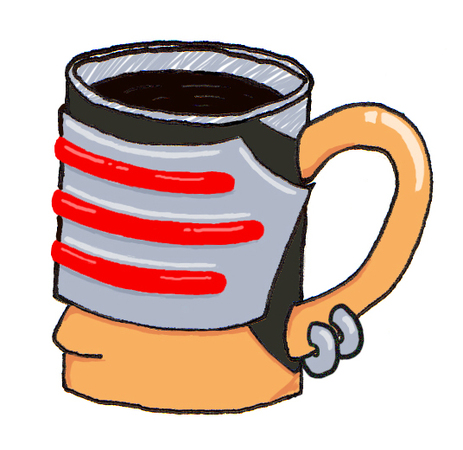
A doodle from 2007… Also, why I’m not an artist.
– Jean Armstrong is not actually French in either the Japanese or English versions, which is why Trés Bien is spelled wrong in the English version and he speaks atrociously bad French.
– Speaking of Monsieur Armstrong, I’d just like to clear up some misconceptions and localization issues surrounding his gender and sexuality. Before I begin though, please keep in mind that societal attitudes and definitions change over time, and that the original Japanese version was made over 10 years ago. Furthermore, Japanese concepts of gender and sexuality do NOT map 1 to 1 onto Western ideas due to vastly different religious, cultural, and historical influences.
In the Japanese version, Jean is a typical “okama” character. At the time, the word “okama” was the generally used catchall word for an “effeminate-acting man”, and had been the go-to word since the Edo period. While that usually implied that the man in question was gay, the word was also used for any biologically male person who did drag or spoke like a woman regardless of their gender or sexuality, and even trans women. Nowadays, similar to the way the word “q u eer” is used in the West (but not entirely the same), “okama” is considered derogatory and discriminatory, though some people will still call themselves “okama”. Since adopting the English word “gay”, it has become more culturally acceptable to refer to actual gay men as “gei” (ゲイ) or the more formal word “douseiaisha” (同性愛者 – literally: “person who loves the same sex”).
Given all of this, what that meant for the localized version was that I had to take a very vague and different concept of “gay” and localize it in a way that would be understandable to a Western audience. Using all of the info we get about Jean in the game, the answer I came up with was that he is a gay, cis man who enjoys performing non-passing drag… Or to put it in a more concrete way, think Conchita Wurst. Jean’s drag persona, which I have dubbed “Campy French Maiden Jean”, is all we ever see during the investigation segments, but in court, he identifies himself as a man to the judge when he is asked what gender he is. Unfortunately, back in 2007, the general public’s understanding of gender and sexuality was not as informed or as nuanced as it is today, so I think Jean still caused a lot of confusion in the English version, but I hope this has cleared it up somewhat.
In terms of how the characters reference Jean, I admit it would’ve been better if they used female pronouns out of respect for his drag persona once they realized it was a persona, but in addition to the fact that I can’t add any extra text boxes to the game, I felt it would’ve been too controversial and hard to explain in-game back then. Furthermore, because he and his persona are not given separate names, it becomes very confusing very quickly as to when the characters are talking about “Campy French Maiden Jean” and when they’re talking about the man/legal witness “Mr. Jean Armstrong”. That said, I feel that society is making progress — to the point where things like calling people by their preferred gender pronoun is slowly becoming the socially correct thing to do — so I hope that someday I won’t need to provide an in-game explanation.
As a side note, given what type of character he is, you can see how he ties into the overall theme of the game, which is “not everything is always what it seems on the surface”.
And speaking of people who are not what people think they are, here’s a bonus fact: Klavier Gavin is not German, but he did study in Germany for a while. We tried to hint at his true nationality with Phoenix saying that Klavier’s accent is “affected” but in hindsight, that may have been too subtle of a hint.
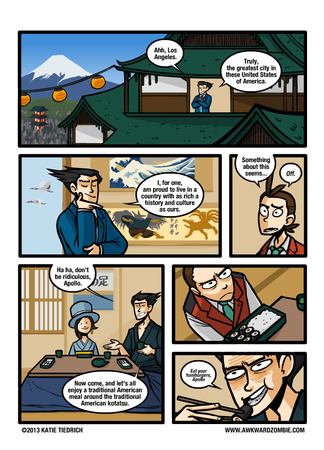
↑ Awkward Zombie – “Culture Schlock” by Katie Tiedrich
( awkwardzombie.com/index.php?page=0&comic… )
– While I’m sure that every fan on the planet has seen this wonderful comic by now, I just wanted to say one thing in my defense – OBJECTION!
When I took over the series’ localization direction starting with the second game, one of the first things I had to deal with was what to do with Maya’s hometown and all the mysticism surrounding the Fey clan. It was then that I created a little headcanon for myself (which I suppose is actually real canon now for the localized version): while “Gyakuten Saiban” takes place in Japan, the Los Angeles that “Ace Attorney” takes place in is an alternate universe where anti-Japanese sentiments and anti-immigrant laws were not enacted, and Japanese culture was allowed to flourish and blend into the local culture in the same manner as other immigrant cultures.
Not counting budget and time restraints, this little headcanon has pretty much dictated what I would keep as Japanese and what to completely localize. For example, anything related to Maya’s clan and the Kurain Channeling Technique is pretty much guaranteed to stay Japanese because that’s her heritage while Japanese foods that are not commonly known in the West will probably be localized in the interest of keeping the game from needing a 50-page explanatory booklet.
By the way, random facts: I adore the fandom name “Japanifornia”, and imagine my surprise when I first saw the “Big Hero 6” movie trailer! No matter what anyone says, Japanifornia will always be THE ORIGINAL San Fransokyo to me. *grin*
– The Judge’s Canadian brother came about because fellow localization director Andrew Alfonso, who helped edit AA3, is Canadian himself and wanted to show his Maple Pride.
– Luke Atmey’s catchphrase at one point during the translation process was “Schwing!”, but I changed it to “Zvarri!” because I felt it was catchy and eccentric like Atmey himself, and a ton of fun to say! The word itself doesn’t mean anything in any language that I’m aware of, but sounds identical to the Japanese word Atmey uses. The original Japanese word “zuvari” (ズヴァリ) is also not exactly a real word, but is based on the word “zubari” (ズバリ – lit. “frankly”, “decisively”) which is often used on Japanese infomercials as a sort of catchphrase/sound effect along the lines of “BAM!” as in, “And the price of this dice-n-chopper is only… BAM! $9.99!”
– Ever wanted to see a few of the other fonts we could’ve gone with for Feenie and his ridiculous sweater…?
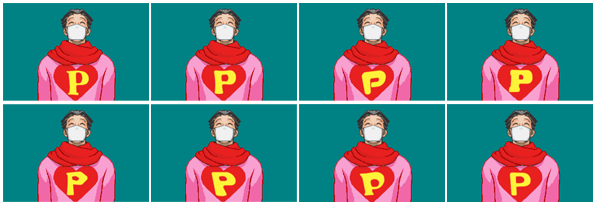
Can you tell which one we eventually went with?
=====================================
Phew, that was a lot of trivia, but I hope everyone enjoyed them! There is so much more that I didn’t get to share, but there is also always the future!
Join me next time–

As Phoenix said, Happy Halloween, everyone! I’m looking forward to seeing your pumpkins and cosplays 2 ! And finally, here’s the absolute last tidbit I’ll be sharing today. TAKE THAT!
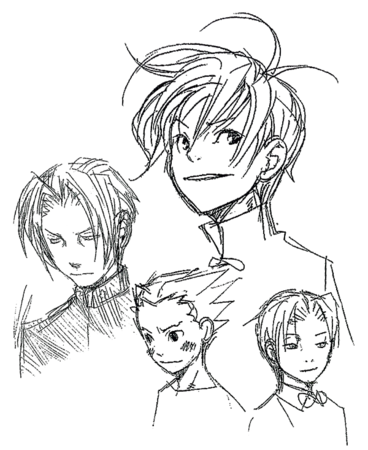
Edgeworth: Gnrk! Why do you have rough design sketches of me as a child?! And what is Wright doing there, blushing like that?!
Janet: …You’re going to have to ask your designer, Ms. Suekane, about that, because I’m not going to speculate.
Edgeworth: This entire entry has been one abominable trick from start to finish!
Janet: Maybe for you, but just remember: one person’s trick is another person’s treat!
Join me next time for another of Mr. Takumi’s blogs. I promise it will be of special interest to people interested in game mechanic design!
Until then!
1 You can see Mr. Takumi in action in these “Ghost Trick: Phantom Detective” promo videos: “Takumi na Magic” pt. 1 , pt. 2 , pt. 3 , pt. 4 (Please ignore how terrible of an audience we on the Ghost Trick team were – Mr. Takumi had to prompt us to respond more and clap, haha – and stick around after the 4 th video for Mr. Takumi’s Top Pomeranian — Missile!). By the way, “Takumi na Magic” is a pun on his name and the word “takumi”, which means “clever”, “masterful”, and even “ingenious”, depending on the context. Mr. Takumi says he often feels the need to state that despite his name sounding like a pen name that literally translates into “Clever Ship” (巧 舟), his name really is “Takumi Shu”.
2 Please excuse my horrible pumpkin pics that were taken with my phone 3 years ago under terrible lighting and were not supposed to see the light of day…
Catch up on previous blog entries here!
-
Brands:Tags:
-

Loading...
Platforms:
